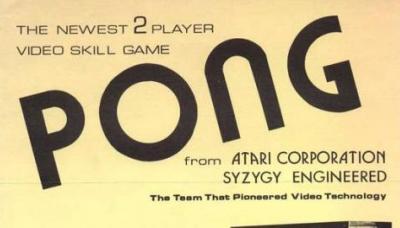Pong (0)

Gameplay
Pong, widely considered the first commercially successful video game, is a 2-D arcade game that simulates . Meant for two competitors, each player takes control of a paddle on that can move vertically along the edges of the screen. The paddle is used to hit the ball back and forth and players earn a point when the opponent fails to return the ball and it travels off screen.
Lawsuit from Magnavox Odyssey
In May of 1972, Atari co-founder Nolan Bushnell was sent by his then-employer Nutting and Associates to demonstration event for the Magnavox Odyssey (the first home console). Of the games being showcased for Ralph Baer's Odyssey, it is likely that Table Tennis caught Bushnell's eye. When Atari released Pong in the arcade later that year, the resemblance (and success) was enough to catch the attention of the Magnavox's development company Sanders Associates. After two years of Pong and its many clones' continued financial successes, Sanders Associates and Magnavox filed a lawsuit against Atari, Bally Midway, and Chicago Dynamics for infringement on their exclusive rights to the Odyssey's copyrights. Magnavox argued that Atari had knowingly infringed on Baer's patents and his concept of electronic ping-pong, though Atari defended by citing the difference between the electronic and digital composition of each game. settled with Magnavox out of court and Magnavox offered Atari an agreement to become a licensee for $700,000 (USD).
Home consoles
The idea for a home console version of Pong was first conceived in 1973 and a prototype was designed by , and Harold Lee during 1975. Eventually in June 1975, the Pong console was demonstrated at the Consumer Electronics Show. At first very little interest was shown by the major retailers because the retailers believed that the public had no major interest in video games at the point in time. So in distress Atari contacted Tom Quinn, the sporting goods buyer for . Quinn was familiar with the Pong game found in arcades and bars, and decided to take a chance on the new console. He met with Nolan Bushnell and asked how many units Atari could produce for the Christmas holiday season. Bushnell reckoned that they could produce 75,000, but Quinn wanted 150,000 units and offered to pay to boost production to that level. Because of this deal, Sears would become the exclusive retailer of Pong under the Sears Tele-Games label. Christmas 1975 turned out to be the most successful period for sales of Pong home consoles, with customers lined up outside Sears stores waiting for new shipments of the game to arrive.
Free-to-play Versions
A version of Pong, with no gameplay changes, was released under two names: Dr. Pong, and Puppy Pong. These versions started at the press of a button, instead of inserting coins. Dr. Pong was built into shelving, and was made for use in venues such as doctor's office waiting rooms. Puppy Pong was essentially the same thing, but with a cabinet shaped like a doghouse with a puppy on it, so as to appeal to children. Puppy Pong was originally developed as Pong, but the design was changed to avoid copyright issues.


